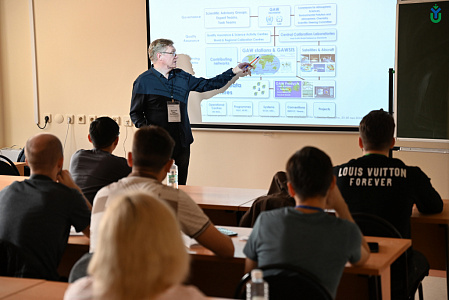Engineering and methodological school on work with greenhouse gas monitoring equipment “CARBON-TECH” was held in YuSU. The participants were engineers of carbon polygons, laboratories, centers involved in greenhouse gas monitoring.
In his welcoming speech to the participants, Acting Rector Roman Kichanov noted that the staffs of the Environmental Dynamics and Global Climate Change Research Center have valuable practical skills and competencies, which they are always ready to share in order to solve state environmental problems.
The participants had a whole week of educational lectures and practical training.
The training began with the study of programming of automatic weather stations. Egor Safonov, Associate Professor of the YuSU Engineering School of Digital Technologies, told in detail about the principles of work on the ISO network model, MODBUS and Arduino platform. The trainees mastered the C++ programming language, focusing also on the RS-485 interface, on which the data system of meteorological stations is based.
“Providing all participants with an Eddy covariance station for the training process is technically impossible. Not every lab can offer a station for training even its own engineers. In this regard, I initiated the introduction of a course about Arduino in the school program. Arduino, which we will talk about, are based on the same principles of operation, and if you understand the basics of such systems, understand how microcontrollers work, you will be able to work on them absolutely any idea. During the course, we will build a small system using partly the same sensors that are used in professional weather stations,” said Vitaly Avilov, a researcher at the Sukachev Laboratory of Biogeocenology at the Severtsev Institute for Problems of Ecology and Evolution of the Russian Academy of Sciences.
Egor Dyukarev, leading researcher of the Laboratory of Ecosystem-Atmospheric Relations of Forest-Swamp Complexes YuSU, Laboratory of Physics of Climate Systems IMCES SB RAS, introduced the participants to chamber methods of greenhouse gas measurement. He told about the main developments in this field, elaborated on the pros and cons of the method and demonstrated what the chamber system consists of.
Vitaly Avilov gave a lecture and practical sessions dedicated to the method of eddy covariance, which he has been practicing for almost 13 years. Having a biological education, he once became an engineer and conducts his activities from installation of equipment to obtaining primary data.
“This course is for those teams that have already started to make measurements, to improve the skills of engineers in equipment maintenance, in proper operation and in obtaining continuous and quality data from measurement stations. We explored the application of the microturbulent pulsation method to measure ecosystem greenhouse gas fluxes. In my time I have also done a lot of chamber measurements. I believe that it is worthwhile to know not only your own area of expertise, but also what your colleagues are doing. Usually, measurements are carried out jointly, and if desired or necessary, you can replace each other at the measuring stations,” said the speaker.
“I would like to note the level of training organization. YuSU welcomes guests very warmly, we all feel at home here, we can feel the atmosphere of our native land. The university fascinates with everything, from the beauty of the university itself and its surroundings to the students and teachers,” shared his impressions of the course participant Vazir Gimazetdinov, an employee of the Ufa Federal Research Center of the Russian Academy of Sciences.
The final stage of the training was conducting research at the laboratory-field station “Mukhrino”. Despite bad weather conditions, it was possible to do all the planned work, and the nature of Siberia conquered the hearts of all.
“We gained a huge experience and knowledge baggage for further work. We installed a system for monitoring atmospheric indicators. The instruments will read local climate data for many years. This will allow us to characterize the conditions of the area and their changes. We also started installing cameras that calculate the concentration of gases (chamber method). The installations calculate the concentration of the main greenhouse gases in the atmosphere, water vapor, methane and carbon dioxide. These studies are the main areas of work of the carbon polygon,” Vazir shared.
The week at the CARBON-TECH Greenhouse Gas Monitoring Equipment Engineering and Methodological School was very intensive and productive. All trainees noted the high level of experts, as well as the balance of the educational program.
Organizers: Yugra State University, Scientific and Educational Center “Environmental Dynamics and Global Climate Change” (UNESCO Chair) with the participation of the A.N. Severtsov Institute for Problems of Ecology and Evolution of the Russian Academy of Sciences, Institute for Monitoring of Climatic and Ecological Systems of the Siberian Branch of the Russian Academy of Sciences.
